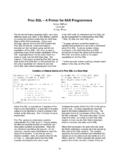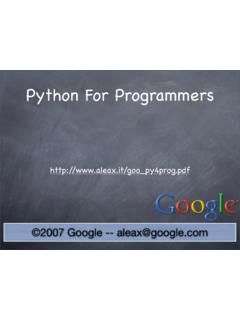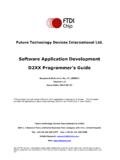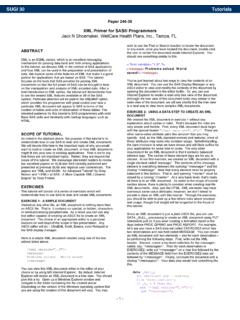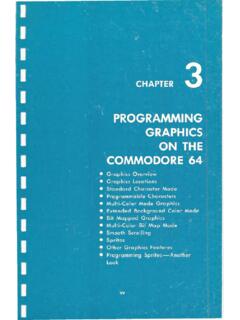Transcription of 250-31: The SQL Procedure – A Primer for SAS® …
1 1 Paper 250-31 Proc SQL A Primer for SAS Programmers Jimmy DeFoor Associate Project Manager Data Base Marketing CitiCard Irving, Texas Abstract The Structured Query Language (SQL) has a very different syntax and, often, a very different method of creating the desired results than the SAS Data Step and the SAS procedures . Only a very thorough manual, such as the SAS Guide to the Proc SQL Procedure , could even begin to describe the complete syntax and capabilities of Proc SQL. Still, there is value in presenting some of the simpler capabilities of Proc SQL, especially those that are more efficient or easier to code than the SAS Data Step. The reasons: 1. The tables created by Proc SQL can be read by the SAS Data Step or SAS procedures , so the SAS programmer can choose to use only some SQL code without impacting the rest of his or her SAS code. 2. Understanding Proc SQL can aid the programmer in understanding other SQL code, such as DB2 and Oracle. Approach This paper will assume that the reader is a capable SAS programmer , but is fairly uninformed about Proc SQL.
2 It will use familiar coding techniques in the SAS Data Step and SAS procedures to teach the syntax and function of Proc SQL as it shows some of the unique capabilities of the Proc SQL. The method of instruction, in general, will be to define a particular coding objective and then show how that objective could be accomplished with typical SQL code and then with typical SAS code. Thereafter there will be a discussion of the purpose of portions of the code and the reason for the syntax that was used. General Proc SQL Syntax Proc SQL options; Select column(s) From table-name | view name Where expression Group by column(s) Having expression Order By column(s) ; Quit; Proc SQL works with columns, rows, and tables, but they are the equivalent of variables, observations, and SAS data sets. In fact, SAS uses only the terminology of columns, row, and tables in the SAS explorer window for both SAS data sets and tables. The browser makes no reference to variables, observations, and data sets.
3 TutorialsSUGI31 2 The Select statement determines the columns that will be retrieved and the operations that will be performed on them. The From clause states the source of the rows and columns. The Where clause limits the rows read from a table, while the Having clause limits the output of the summary operations executed upon the rows. Having clauses must be used with Group By clauses or with functions that operate on all rows that were retrieved. A Group By clauses put the rows into the unique groupings of column values, but it does not order those groupings. If a descending or ascending order of columns is required, an Order By clause must be used. Ascending is the default. Examples of SQL Code and Comparable SAS Code Example 1: Creating an output listing with Proc SQL versus a Data Step Filename out C :\ new; *; Proc Printo print=out; Run; *; Proc SQL; Select monotonic() as obs, , as Town, , , , , , from Cost a; quit; Filename out C :\ new; *; Proc Printo print=out; Run; *; Proc Print data = Cost; Label City = Town ; Var State City Store Year Month Sales VarCost FixedCost; Run; Since Proc SQL is a Procedure , it requires a previous Proc Printto to be executed if the listing output is to be directed to a text file instead of the default list file SAS uses.
4 Proc Print has the same requirement Proc Print generates observation numbers automatically; Proc SQL doesn t. Observation numbers can be generated only by adding Number as an option on the Proc SQL statement or by adding the undocumented function of monotonic to the Select statement. The Number option is ignored when a table is created, however, while the monotonic function isn t. The monotonic function is shown here. Notice the reference of as that follows monotonic . It provides names to the results of functions, but it can also be used to rename variables. In this Select statement, it names the results of the monotonic function as Obs and renames City to Town. The Label statement in the Proc Print code accomplishes the same result as far as printing is concerned. Compare the syntax of the Proc SQL to syntax of the Proc Print. Doing so reveals the basic syntax of Proc SQL. Commas separate the variables listed in the Select statement of Proc SQL. The Quit statement is the terminator of Proc SQL, not the Run statement.
5 The semi-colon does not end every instruction, as it does in usual SAS code. Instead, it ends only the SQL Select statement, which is really the only statement in SQL. When SAS encounters the semi-colon that ends the Select statement, it passes all of the preceding SQL code to the SQL compiler. The compiler separates the Select statement into individual SQL clauses as it encounters such key words as From, Where, and On. It then evaluates the clauses and passes them to the execution module if they are syntactically correct. Thereafter, SQL processes all of the clauses and waits for another Select statement unless it encounters a Quit statement or another SAS step. Thus, Proc SQL can create multiple tables and/or listings until it is closed. TutorialsSUGI31 3 One unique and important feature of Proc SQL is that columns can be defined relative to the data set in which they occur. This is shown by the references above, such as The programmer creates an alias by following the table name with a shorter name (as in Cost a).
6 He or she can then attach the alias to the front of the variable name with a period. This ability to reference variables by their data sets allows multiple variables with the same name to be manipulated by Proc SQL. This will be shown in Example 11 when a table is created by joining two other tables. Example 2: Creating a table with Proc SQL versus creating it with a Data Step The simplest way of creating a SAS data set or table is to read into it all the variables and records of another SAS data set. In the code below, the Select * syntax retrieves all variables from the Measures data set. The SAS Data Step retrieves all variables by default. Only the presence of a Keep or Drop statement as a Data Set option prevents all variables in the input data set from being read into the SAS Data Step. SQL either retrieves all variables or only the specified variables. It does not explicitly drop variables. Keeping all columns from the source table regardless of order Proc SQL; Create Table Work1 as Select * from a; quit; Data Work1; Set ; Output; Run; The code below shows the Select statement retrieving particular variables from the Measures data set and writing them to the table Sales.
7 As discussed above, the Data Step must accomplish the same result via a Keep, which in this case is the Keep= data set option. However, the Select statement has another result that cannot be easily duplicated in the SAS data step. It orders the variables as it retrieves them. The Keep statement, in any form, does not specify order. Only Length statements or Format statements will set the order of variables in a Data Step and they must be placed before the Set statement if they are going to determine the order of all variables in the data set. The problem is, however, that they require some knowledge of the variables content and existing formats if they are to be used effectively. The SQL Select statement does not require such knowledge. Keeping and ordering particular columns from the source table Proc SQL; Create Table Sales as Select , , , , , from a; quit; Data Sales; Length State $12 City $20 Store $06 Year $04 Month $02 Sales 8; Set (keep= State City Store Year Month Sales); Output; Run; TutorialsSUGI31 4On the other hand, though the Data Step cannot match the ease of variable ordering that can be done in Proc SQL, it can output multiple records to the same data set or to multiple data sets very easily.
8 For example, the data statement above could easily be modified to write part of the record to Sales and part to a data set named CityList. Data Sales(keep=Sales) CityList(keep=City); Proc SQL would require two Create Table clauses with different Select statements to accomplish the same result. The next example discusses sorting data with Proc SQL and computing new variables. Example 3: Creating and assigning columns and selecting and sorting rows Proc SQL; Create Table Stats as Select , , , , , , sum( , ) as TotCost, from a Where state = TX Order by State, City, Store, Year, Month ; quit; Proc Sort Data = Cost (keep=State City Store Year Month VarCost FixedCost where=(State= TX )) Out = Subset; By State City Store Year Month; Run; *; Data Stats(drop=FixedCost); Set Subset; Totcost = sum(Varcost, FixedCost); output Run; The above examples perform four actions: 1.
9 Selects only particular variables such as City, State, Store, Year, Month, and Varcost. 2. Retrieves values for those variables from only the state of TX . 3. Orders the rows by State, City, Store, Year, and Month. 4. Creates a Total Cost field. In both examples, the sum function was used to create the values of TotCost from the values of VarCost and Fixed Cost. Other calculations and assignments could have been done with very similar coding. The only difference would have been the form of the syntax. In SQL, the form is Action > Target. In the Data Step, the form is Target < Action. This is shown below. SQL Data Step ( * Cost) as Price Year||Month as Yearmo Substr(Store,1,3) as StoreArea Price = * Cost; Yearmo = Year||Month; Storearea = Substr(Store,1,3); In this example, the SQL code performed the sorting with an Order clause after it executed the selection, calculation, and assignment. The SAS code selected, sorted, calculated, and then assigned.
10 For the SAS code, this was by choice. The sort could just as easily been executed after the Data Step as before. But Example Six builds on this code and it requires that the sort be done before the summing. TutorialsSUGI31 5 TotCost is calculated in both the SQL and Data Step code via the Sum function. The capabilities of the SQL Sum function are more extensive than the Sum function in the SAS Data Step, however. In the Data Step, the Sum function always sums over columns. In SQL, it sums over rows if only one column is listed in the Sum function and sums over columns if two or more columns are present. Since functions can be nested, a Sum function in SQL can sum over rows the result of a Sum function that summed over columns (see below). sum(sum( , )) as GrandTotal In this case, GrandTotal would be the sum of all rows of variable and fixed costs in the entire table. Example 4: Creating columns with Case expressions and user-built formats In SQL, case expressions and user-built formats are very useful methods of assigning values to a variable based upon the values of other variables.











